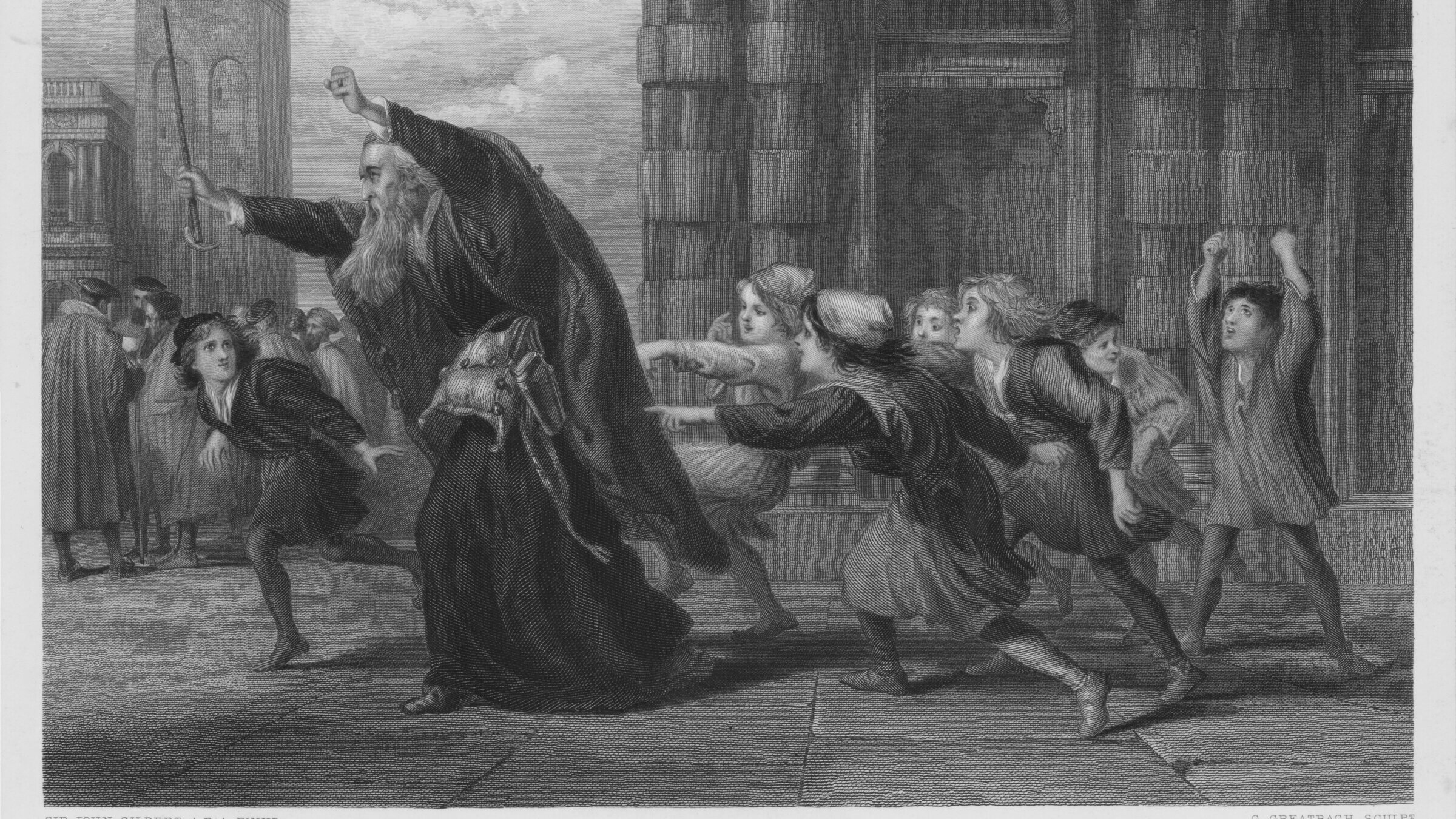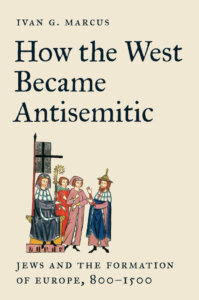So, how did the West become antisemitic?
Scholar Ivan Marcus examines the origins of the world’s oldest hatred

An engraving of Shakespeare’s ‘The Merchant of Venice.’ Photo by Getty Images
Before the present noxious morass of publicly expressed antisemitism, wry semi-humorous statements were fashionable, such as “Jews are just like everyone else, only more so,” variously attributed to the philosopher Isaiah Berlin or a British rabbi, Lionel Blue.
The implication was that Jewish people tend to provocatively cause a tzimmes and raise hackles. According to this thesis, a penchant for words and deeds likely to offend may have sparked the wrath of adversaries.
This belief is newly analyzed in How the West Became Antisemitic, an erudite overview by religious studies scholar Ivan Marcus.
Marcus concludes that there is “little hope that diaspora Jews will cease to be victims of some forms of antisemitism” as long as other groups reject an egalitarian, live and let live attitude. Even so, knowing the history of the often-vituperative slanging match that was inter-religious communication may be the first step for dialing down the internecine hatred.
Author of The Jewish Life Cycle and Rituals of Childhood: Jewish Acculturation in Medieval Europe, Marcus here focuses on verbal derring-do in polemical texts produced by historical Jewish authors who wanted to assure readers that Judaism was the only true option as a religion.
Prone to using wordplay to make a point, this approach was exemplified by the Sefer Nizzahon Yashan (The Old Book of Victory), an anonymous 13-century Jewish apologetic text from Germany that disses Christian saints as “sacred prostitutes” (qedeishim) instead of “holy beings” (qedoshim).
Even more daringly, the text refers to the Virgin Mary, mother of Jesus, by a rhyming Aramaic term for feces (hariyya) instead of Maria, her correct name in that language. What Marcus deems “insult language” in a wide range of Jewish texts across the centuries captures an annoying, obstreperous tone in the biblical tradition of “laughing to scorn” (as in the Book of Kings).
Vehement Jewish ridiculing of other faiths, Marcus points out, was followed by widely believed, albeit fictional, antisemitic calumnies from others. And whereas Jews ridiculed symbols of Christianity, Christians vilified Jews in personal terms.

Sefer Toledot Yeshu (The Book of the Generations of Jesus) is a non-canonical medieval text which descends into insult and fighting words, sneering at Jesus as the “son of a prostitute” (ben zonah), and in some editions, “son of a menstruant” (ben niddah).
This grim discourse is echoed in “The Solomon bar Simson Chronicle,” an anonymous Hebrew narrative history produced in the mid-12th century about persecutions of Jewish communities in the Rhineland area during the First Crusade.
It features Meshullam ben Isaac, a Jew from Worms, Germany, who is reported to have killed his wife and son before committing suicide, rather than grant the Crusaders the privilege of slaughtering his family. In so doing, the chronicle claimed, Meshullam ben Isaac outdid the Hebrew patriarch Abraham, who was merely called upon by the Almighty to sacrifice his son.
Other Jewish martyrs dismiss Jesus as a “putrid corpse” and assert that Christians will be consigned to “boiling excrement” in the afterlife. Yet as historian Alexandra Cuffel has emphasized, Jews had no monopoly on invective. Jews, Christians and Muslims alike shared a discourse that like the paintings of Hieronymus Bosch, freely mixed the sacred and abject.
Part of the motivation may have been one-upsmanship, a universal human flaw. In 1205, Pope Innocent III complained in a missive that in Sens, north-central France, a synagogue had been built to tower over the local church. There, “insolent” Jews celebrated religious rituals “with great shouting” that disturbed church services.
Marcus details how “Jews provoked Christians to defend their religious beliefs and practices that Jews thought were of no value,” but stops short of claiming that the centuries of “aggressive Jewish attack on Christian beliefs” somehow prepared the ground for the Final Solution of World War II.
As with other instances of extreme inhumanity, pogroms and genocide ultimately defy attempts to rationalize or explain them. So that while some medieval Jews, or at least those who left written records, may have had uppity self-images as knights superior to the Christian rabble, as Marcus recounts, even centuries of sharp-tongued Jewish taunts could scarcely be seen as a cause for the mass murder that ensued.
Verbal abuse was succeeded by physical action, although unlike printed words, this is necessarily anecdotal and unverifiable in the pre-TikTok age. Marcus cites a 12th century account of a French Jewish pawnbroker who concealed some illicitly received church objects by placing them in a latrine.
Even during centuries of relative peace and harmony, Jews continued to pour fecal insults on Christian adversaries with élan. As a result, with a certain vengeful flourish, Christians enacted sadistic scenes suitable for a theater of cruelty.
In one such, the 14th century Benedictine monk Ranulf Higden claimed that a Jew in Tewkesbury, northern Gloucestershire, England, fell into a public latrine one Shabbat and refused to be rescued as that would have represented laborious effort on the sacred day. In response, the count of Gloucester declared that the next day, Sunday, was one of rest for Christians, so no one could assist the unfortunate Jew, who died unrescued.
As mutual actions amped up in offensiveness, Jewish accounts described how Jews defiled Christian sacred objects as a sign of bravado. Ephraim of Bonn, a rabbi who documented the massacre of the Jews in the city of York in 1190, noted that a Jew named Qalonimos of Bacharach “openly spat” on a crucifix and Christians “slew him on the spot.”
Anecdotal accounts of Jews committing even more extreme acts of profanation include one tale where the offender had the chutzpah to justify his deed. A 13th century French rabbi mentioned by Marcus kvelled that his father, a Rabbi Nathan, once dismounted from a horse to urinate on a crucifix, after he saw a nobleman urinating on a bush. To the Frenchman’s objections, the rabbi alluded to the burning bush in the biblical Book of Exodus from which the deity spoke, as superior to a cross which to the rabbi symbolized malodorous, putrid defeat.
Comparably, “Sefer Nizzahon Yashan” contains a story about a moribund Jew named Jacob who on his deathbed first called for a crucifix to pay homage to, but then reconsidered, placing the object “under his anus.”
The image of the Jew as “avenger of his suffering,” as Marcus terms it, continued into the more recent past, even in the absence of Jewish populations in Elizabethan England, where it may be seen in Christopher Marlowe’s play The Jew of Malta and most devastatingly, Shakespeare’s Merchant of Venice.
These fictionalized Jews attacked Christians personally, no longer merely focused on symbols of Christianity as in the past. Yet this newfangled excuse for loathing may be traced back to medieval antisemitism, which helped create and legitimize the modern variety.
Insofar as Christian antisemitism objects to Jews themselves more than to Judaism per se, even our secular age when fewer Jews are observant cannot diminish it. Marcus understatedly notes that this “recycling” today of the “medieval structure of antisemitism” is a reasonable subject for concern.
So readers of this illuminating book are informed, if not comforted, about Jewish historical fate.
A message from our Publisher & CEO Rachel Fishman Feddersen

I hope you appreciated this article. Before you go, I’d like to ask you to please support the Forward’s award-winning, nonprofit journalism during this critical time.
We’ve set a goal to raise $260,000 by December 31. That’s an ambitious goal, but one that will give us the resources we need to invest in the high quality news, opinion, analysis and cultural coverage that isn’t available anywhere else.
If you feel inspired to make an impact, now is the time to give something back. Join us as a member at your most generous level.
— Rachel Fishman Feddersen, Publisher and CEO
























